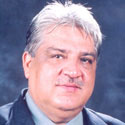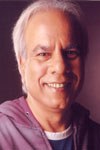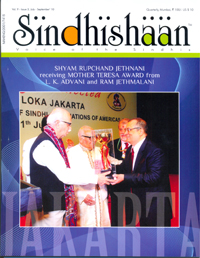COMMUNICATION – THE LANGUAGE CRISIS
A Contrarian View
One hears the constant lament at Sindhi Seminars, Sammelans and gatherings that the language is dying, and as a consequence so will Sindhyat. The survival of the language should be our topmost priority and we must all strive to ensure its survival.
Well, Sindhishaan presents contrarian views presented by none other than Dr. Satish Rohra and Arun Babani for its readers to reflect on.
Please give us your feedback on the views expressed by these two writers who submitted these articles independently, without being aware of the others’ views.
Ranjit Butani

Let the Mouth Survive, Let the Body Perish
Dr. Satish Rohra

We need to have a cultural bypass surgery; which means moving from culture to language instead of language to culture.
Recently I watched a serial in which a father had got his son admitted to a hospital because of an infection in his foot. The doctor tried to treat the child with medicines, but they finally concluded that the foot had to be amputed because if they don’t do it immediately, the entire leg would have to be amputed later. Left with no other alternative, the father agreed to the operation. When the staff were taking the child to the operation theatre they noticed that the father was searching for the child’s slippers. They were rather surprised and questioned the father. The father replied “What will I reply to him if the child asked for his slippers after the operation?” The staff looked at each other thinking what reply would the father give to his child if he asked about his foot?
Quite on similar lines is the thinking of the well wishers within the Sindhi community. They don’t realize that the Sindhi language is not something separate and isolated. Language is a means of communication with society, and for the study of literature of that community. Language is a means to acquire knowledge about the cultural heritage of the community. When such objectives are not met through language, how is it possible to save literature and culture merely by speaking the language?
Those who have written articles referring to the essay in the Times of India haven’t read the title of that essay, which is ‘Sindhi culture is on the ventilator’. I don’t know why these Sindhi scholars don’t understand that the Sindhi language is one part of the Sindhi culture. Yes, may be it is a very important part even though it is just one of the parts of the Sindhi culture. It is just like the mouth which is one part of the body. It is true that the food ingested by the mouth delivers energy and strength, but that does not mean that one should preserve the mouth and let the body perish. One has to abandon the misconception that if the mouth is saved the body will be saved. The entire body is more important than only the mouth. All this hue and cry by the scholars about saving the Sindhi language is akin to efforts to save only the mouth and that is why they fail. We need to accept and consider language as only a means of communication and there are several languages of communication. Apart from Hindi and English there are many other regional languages available for communication. Then why should we learn Sindhi language when it is so limited in its reach. Which means we can use it only at home and that too only when an elder is present. But the scope of other languages is quite vast which can result in communication with a wider audience.
Besides communication language is also needed for the study and creation of literature. Through literature one learns about the life, the history and the culture of the community. The extent to which Sindhi literature is being studied is clear from an unfortunate example given by famous Sindhi novelist and Sahitya Academy award winner Shri Anand Khemani who published a collection of three novels. There was only one buyer for those three novels, who paid and ordered for the same. According to Anand even one such reader is quite important and sufficient. I have to tell you that nowadays around a hundred Sindhi books are published every year and there is this one buyer who has turned up our way. This year there may not be even this one. Then why are we crying so much for the Sindhi language?
Actually the entire confusion is about not understanding the vital difference between language and culture. Earlier too, I had pointed out that it is not possible to take the route from language to literature, and then from literature to culture in the present circumstances. We need to have a cultural bypass surgery; which means moving from culture to language instead of language to culture. It is quite obvious that the Sindhi culture is quite popular among the youth today and awareness is growing by the day. Nowadays in every small town there are Jhulelal temples and Sindhi Dharamsalas where Chetichand and other cultural programs are being celebrated. Exhibitions are held, music and theatre groups are being invited. For example in a small city of Gandhidham great cultural events are held and a massive collection of people gather. It is an open invitation where Sindhis and non Sindhis are invited for the afternoon lunch. Thousands of people gather for this event and in the evening a beautiful cultural program is organized. All this is organized by the youth of the city with great gusto and passion. In every city of India such programs are being held. What does all this indicate? All this indicates that a large portion of the Sindhi community, especially the young generation, is becoming aware of the Sindhi culture. The well-wishers of the Sindhi community should take advantage of this awareness of the Sindhi youth and teach them about the great history of Sindh as well as the qualities and values of Sindhis. They should also tell them about eminent Sindhi personalities as well as great Sindhi dramas, music and Sindhi literature.
The government must help us out in this because it is our right. But the government alone cannot bring this cultural awareness and it cannot change our behaviour. That is why Sindhi organizations and panchayats should enhance this awareness of Sindhi youth by organizing high quality Sindhi programs so that non Sindhis can have empathy and sympathy with our community and respect our high values. We must strive to keep the whole body vital, vibrant and healthy, and not only concentrate on the mouth.
What has the tongue got to do with it?
Arun Babani

A DNA report says the BMC has shut down 64 vernacular schools in the past 5 years. On the same page another report says BMC will reply only in Marathi to all the queries of the residents in the H-ward,which includes Bandra,Khar and Santa Cruz, the predominantly non-Maharastrian localities of Mumbai.Earlier the same newspaper carried a report on Sindhi organizations offering cash prizes and mobile phones to youngsters speaking in Sindhi.
Let us now examine the role of language in human life. On the very first day an infant does all that she needs to do to survive:eats,drinks,defecates,smiles,recognizes and holds. Within a week she asks, demands and relates. Within 6 months she talks, understands and responds in her own babble. Later, in school, she is taught the subject of living and surviving in society and culture. Human beings from all cultures and languages of the world do the same: make her fit the social fabric. Educating her for the first 25 years, marrying her first to her profession and then to a partner. Together the two raise a family and attend office for the next 25 years, retiring at 55,giving the reigns to their offspring who then repeat the same social cycle.
The tongue, the language in use through their lifespan may vary, but this basic structure of human development remains the same. All through the centuries of human history and every where in the world, this is the human conduct. This is the only model we have had so far, and this is the only world we know, the only human society that has survived so far. Take it or leave it this is called the human culture. There are about 3000 languages on the earth and around 300 religions. It is discovered that religions are the parents of the languages that we speak.
Now let us ask a simple question. In this survival game of life, with three basic human needs of food, clothing and shelter, how essential is the tongue, the language that one speaks? In this age of free talktime and Twitters,the words have lost their value. Ancient sages spoke profound truths in short telegraphic Sutras, whereas today’s young girls travel with trivia of 2 hours on their cell phones. In eating and cultivating your food or clothing, or building your house, language is the last thing you can imagine. Higher qualities like the music and dance, the painting and the Arts don’t use words at all. Even the areas like the religion, politics, science and technology, where communication and language is necessary, any language, like any scientific tool , is good enough without the notion of superior or inferior simply because the language is only a container with contents being the same in all societies,with the same survival kit handed done from generation to generation.
The Chinese call it Tao, Hindus pronounce it as Dhyan and the Europeans have learnt to say it as Zen.The tea gets transformed into Cha in Thailand and Chai I India. But everywhere the taste is the same. How important then is to hold on to Chanhe as Sindhis pronounce it and then fight the evil word Tea as the English utter it?Chai-ldish isn’t it !?
This entire hullabaloo about ‘saving and promoting’ a language seems to be based on a limited understanding of human nature. Further, it creates divisions and conflicts in society. It is basically a power politics. The more the language users in a community the more powerful it considers itself, so much so that it i then gets a political force to submit other languages to its power. Since it is blind to basic human nature, conduct and needs, it is therefore doomed to fail. Now with the Mystics speaking of the language of silence, and therapists speaking of body-language, and economists using the language of money, the issue of what language your 100 rupee note carries is redundant as the long as the zeroes are correct!
Sindhis need not fear the word Extinction. They should instead the word Re-invention. So, if they have to let go off ‘pyar’ they can reinvent it as ‘love’ which will taste equally the same or perhaps juicier because now they’ll have many more beings to love. So, it is the wordless heart that is at the core of life, the tongue simply wags its tail and barks.


